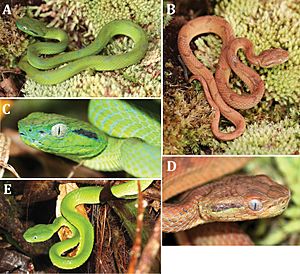Bothriechis guifarroi facts for kids
Quick facts for kids Bothriechis guifarroi |
|
|---|---|
 |
|
| A. Green-phase juvenile. B. Brown-phase juvenile. C. Close-up of head. D. Close-up of head. E. Female. | |
| Scientific classification | |
| Genus: |
Bothriechis
|
| Species: |
guifarroi
|
The Bothriechis guifarroi is a type of venomous green snake. It's a "palm pitviper," which means it lives in trees and has special heat-sensing pits on its face to find prey. This snake was first discovered in 2010 in a wildlife refuge in northern Honduras.
This snake is related to two other types of Bothriechis snakes found in the mountains of Honduras: B. marchi and B. thalassinus. Even though its colors and scales look similar to other Honduran palm pitvipers, its DNA shows it's actually more closely related to snakes like B. lateralis and B. nigroviridis. These relatives live over 600 kilometers away in the mountains of Costa Rica and Panama.
Contents
What Does It Look Like?
Adult B. guifarroi snakes are bright green. They often have a yellowish color on their belly side. Young snakes, called juveniles, can be either green or brown. They change to the adult green color as they grow older. The first adult snake studied was about 73.4 centimeters (29 inches) long, with its tail being about 13.6 centimeters (5 inches) of that length.
Where Does It Live?
The B. guifarroi snake has only been found in a specific area of Honduras. It lives in the Texiguat Wildlife Refuge, which is part of the western Cordillera Nombre de Dios mountain range. Scientists found these snakes at heights between 1,015 meters (about 3,330 feet) and 1,450 meters (about 4,757 feet) above sea level. They prefer areas called "Premontane Wet Forest" and "Lower Montane Wet Forest."
Its Home (Habitat)
This snake makes its home in rainforests and cloud forests. These are types of forests that get a lot of rain and are often covered in clouds or mist. The B. guifarroi is found in these forests at elevations higher than 1,000 meters (about 3,280 feet).
Why It's Named That
The B. guifarroi snake was named after a brave Honduran environmental activist named Mario Guifarro. He worked to protect nature and was killed in 2007 while on a conservation trip in eastern Honduras. Naming the snake after him honors his important work.
Its Future (Status)
In 2013, when this snake species was first described, scientists suggested it should immediately be listed as "Critically Endangered." This means it's at a very high risk of disappearing forever. There are a few reasons for this concern:
- Not much is known about it: Scientists don't know how many of these snakes exist or exactly where all of them live.
- Habitat loss: People might be destroying or changing the forests where these snakes live.
- Pet trade: There's a worry that people might try to catch these snakes to sell them as pets, which could harm their population.
Because of these risks, scientists also recommended that the snake be considered for CITES protection. CITES is an international agreement that helps control the trade of endangered animals and plants to protect them.
Images for kids
See also
 In Spanish: Bothriechis guifarroi para niños
In Spanish: Bothriechis guifarroi para niños




